
The fresh air induction system on the Dodge and Plymouth B-bodies was just well…brilliant! Hood scoops, scallops, and louvers were all used on B-bodies from 1966 through 1968. They had an aggressive look, yet despite being highlighted with chrome and contrasting stripes they were still, just there for looks. In 1969, that all changed.
When Plymouth introduced the Road Runner and (redesigned) GTX models, a cable-operated fresh air induction system – aptly called the “Air Grabber” – was unveiled. Not to be out done, the Dodge line introduced the same system for the Super Bee and the R/T models, in the same exact color, but labeled it the “Ramcharger”. Interestingly, the Charger line never received the fresh air option until 1971 when Dodge combined the Super Bee and Charger models together.
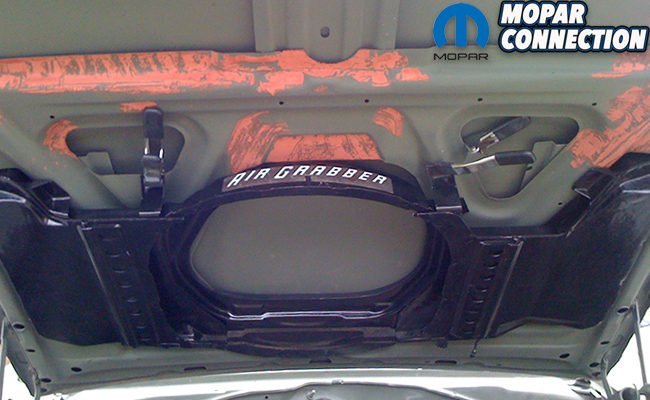
Above: This is a 1969 Plymouth Air Grabber under-hood box. It comes in three pieces. This box is being test-fitted and does not have the rubber seal to the breather attached yet. You can see that the flaps are closed by looking at the holes in the left and right outer runners. The lever that the actuator cable attaches to can be seen in the back of the driver’s side runner.
Top left: Here is an original Ramcharger unit on a 1969 Dodge Coronet R/T. Someone has spray painted over the decal but it can still be seen in its original position. The unit needs to be restored. It is complete and can be restored to be better than new. Reproduction units, though good, are still not as correct as an original unit that has been restored. Top right: Here you can see the rubber seal and the attaching hardware. Though they need replacing they are valuable in making sure that your replacement seal and hardware is correct. Be sure and spray these with penetrating oil and let soak before trying to remove them. The original material that the box is made of is brittle and can break easily. Bottom left: The drain rubber flaps with their unique attaching clips are clearly seen in this up-close picture. Notice that this runner is cracked. You can either repair this with fiberglass and paint or replace this side with a reproduction runner. Bottom right: The Dodge Ramcharger hood came with two hood scoops. They have a chrome front bezel and the engine callouts mounted on the side. This one clearly lets everyone know about the big block 440 that resides under this hood.
The advantage of these fresh air induction systems was instead of the engine drawing in hot air from the engine compartment, it could now get cooler, fresh air fed directly into the engine via a somewhat sealed outside source.
Now that the hoods were modified with the fresh air induction boxes, the breathers had to also be modified to accept the additional fresh air and funnel it into the carburetor and intake. There are many different combinations of these breathers, filters, and their lids. Depending on the particular model, year, number of carburetors, and engine size, you could have a variety of air breather styles.
Above left: Here is an Air Grabber unit that has been cleaned, soda blasted, painted, and had all the of the seals and attaching hardware replaced. It has been painted semi gloss black and a new “Air Grabber” decal replaced. To be completely original in appearance, the unit needed to be soda blasted and sprayed with a mat clear paint. This allows the original unique finish of these units remain intact. If you have to patch the unit you have no other choice but to paint it. It will be close but not exactly as original. Above right: In 1969, the four barrel air breather on the Air Grabber is oval and has the iconic “Coyote Duster” decal applied. The 1969 ½ breather does not have this decal but only has two small rectangular decals with “Do Not Wash or Oil” care instructions on one and “Special Instructions” about sub freezing weather or heavy rainstorm, warnings on the other.
Above left: The hoods for the 1968 and 1969 Road Runners are the same basic structure. The slots in the hood shown here in 1968 opened towards the side of the hood and were solid. The 1969 inserts pointed up. These hood stripes were a one year only style and were painted on with organisol. Above center: The inserts had Ralleye Red painted screens that allowed the air to flow into the Air Grabber box. These screens were painted red with or without hood stripes. Above right: The non-fresh air hoods had ribbed, solid plates mounted in the inserts. They were painted semi-gloss black with or without the hood stripes.
Here are some guidelines for understanding the different applications for the fresh air induction systems:
- From 1966 to 1967 the hood scoops were just for looks and there wasn’t any fresh air induction on Plymouth and Dodge B-bodies.
- In 1969, the “Air Grabber” for Plymouth GTX and Road Runner, and the “Ramcharger” for the Dodge Coronet R/T and Super Bee, were both black. There were different height breather bases for the 383 and 440 engines. The easiest way to identify whether you have a 440 or 383 base plate is lay it on a table and if it rocks. If so, it is a 383 base.
- In 1969 1/2, the fresh air fiberglass hood came only on A12 cars. The scoop had no way to open or close and therefore had to have a bath tub-style breather base with drains for water that may come in handy during operation in the rain. The drains had short sections of heater hose attached the the drain so the water would drip without getting the engine wet. The hood was painted with organisol and had either the decals proclaiming for the Dodge “Six Pack” or for the Plymouth, “6BBL”.
- In 1970, the Plymouth “Air Grabber” became vacuum-operated, changed air boxes and was black while the Coronet “Ramcharger” became orange and remained cable operated.
- In 1969, the Air Grabber/Ramcharger breather lid for the four-barrel and Hemi was the same large oval similar to the 1969 1/2 Six-Pack breather lid. The bases were different for the four-barrel 383 and the four-barrel 440 from the base with the three carburetor holes for the “6BBL” and “Six-Pack” Holley carburetors.
- In 1970, the N96 (fresh air option code) four-barrel breather had a large oval base but a small round filter and lid.
- In 1970, a new larger breather lid without a rain gutter was used on the Six-Pack and 6BBL. The Hemi used the same lid as in 1969.
- The air dam is only on 1970 Six-Pack and Hemi cars without fresh air or California “noise reduction” N97.
- Beginning in 1969, all Hemis (except ’69-’70 Charger or Daytona, Superbird) had fresh air induction.
Above: In mid-year 1969, the A12 cars were produced. These were Super Bees and Road Runners with the special option of A12. They received a full fiberglass hood attached with hood pins. The scoop was open all the time and required the development of a bathtub style base that allowed the water to be diverted away from the 3 Holley 2 barrel carburetors. This hood was painted with organisol and had either the “Six-Pack” or “6BBL” sticker applied to the hood scoop.
Above left: The Plymouth Air Grabber changed completely for 1970. The air box went from a three piece unit that covered the entire width of the hood, to a more compact single body unit. The box still used the same seal as was used in 1969. The unit went from using a manual cable to open and close to a vacuum-operated one. The actuator raised or lowered the scoop when vacuum from the engine passed through a dash mounted switch to the actuator via several rubber hoses that were color coded to identify their position in the system. Above right: The passive inserts from 1969 gave way to a flush-mounted hood scoop that on command, slowly opened revealing the bright orange and white “shark” teeth and mouth to let everyone know this car means business.
The hood may or may not have a stripe with the 1969 Air Grabber. The Ramcharger had hood scoops with the size of the engine badge mounted on the side. If the hood had the V21 stripe option, it was painted with organisol. If the hood had the fresh air option, the screens that allowed the fresh air into the box were always Ralleye Red in color with our without a stripe. If the hood did not have the fresh air package, it had a solid ribbed plate painted semi-gloss black with or without a stripe.
In 1970, the Ramcharger stayed manually-operated by cable but the color of the box was changed from black to orange. The Air Grabber changed completely in style and operation. No longer was it operated by a manual cable, but it became vacuum-operated and the scoop was flush with the hood.
Top left: In 1968 there were not any fresh air systems available for Plymouth or Dodge, even for the mighty Hemi. Top right: In 1970, the 440 Six-Pack or 6BBL breathers that were in a car without the N96 “Fresh Air” option had a protective dam mounted in front of the breather so that fluid/water would not be blown into the induction system by the radiator fan. Bottom left: The manual cable-operated Ramcharger was kept in the Dodge Coronet line, but the color was changed from black to orange to give it a more competitive look. The two stationary hood scoops were also kept from the 1969 model. The four-barrel, smaller round breather used in the Plymouth line was also used in the Dodge line minus the “Coyote Duster” decal. Bottom right: The large style oval breather that was used on the 1969 four-barrels with the N96 option was used with modifications to the base for the three two-barrel Holley carburetors on the Six-Pack and 6BBL engines.
When the switch (mounted on the lower dash) was flipped, the vacuum from the engine went through a vacuum storage canister and caused the actuator to raise the scoop, exposing the menacing “shark” mouth and teeth proudly proclaiming “Air Grabber”. Thus, the ultimate stop light intimidator was ready to rear its head whenever an unsuspecting stop light challenger revved it’s engine.
The V21 hood stripe changed from two equal stripes to three stripes with the middle stripe being the largest. There is a vacuum release solenoid under the dash that allows the scoop to always return to its flush-mounted position when the key is turned off. You can also use the toggle switch on the dash to lower the scoop on demand.



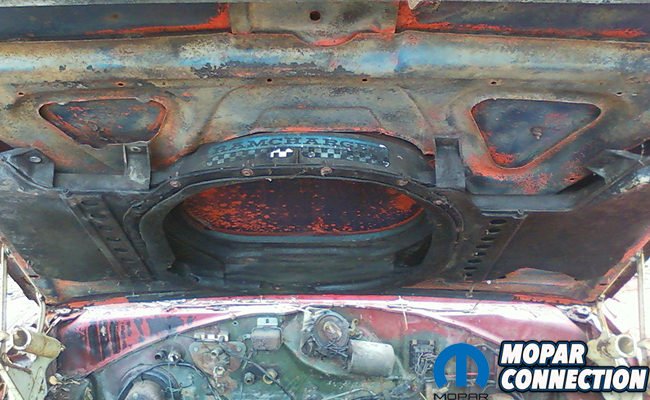



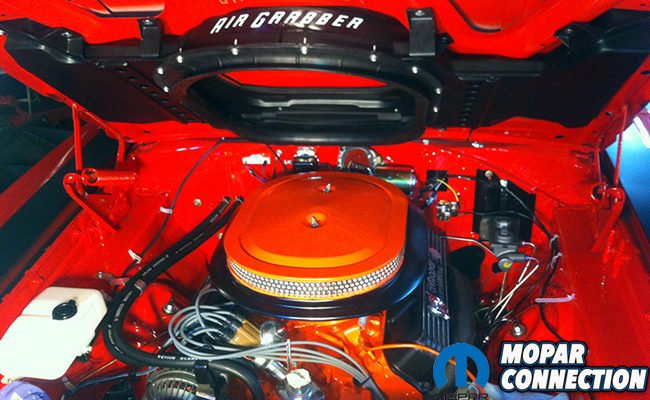


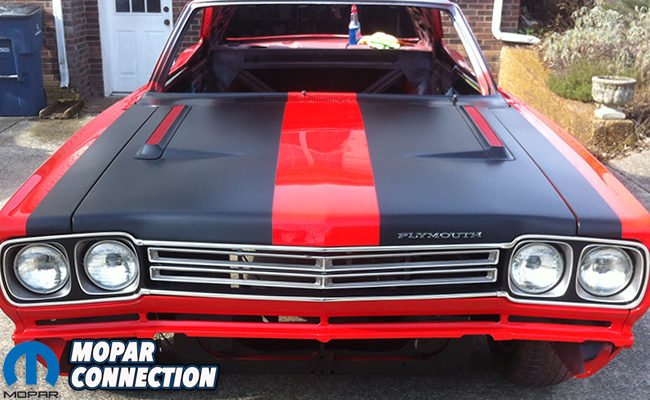
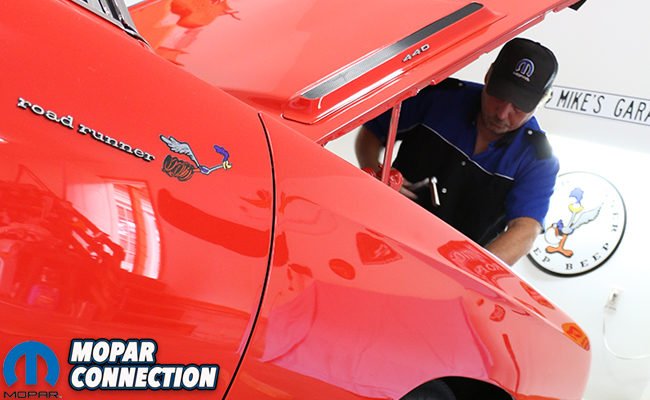
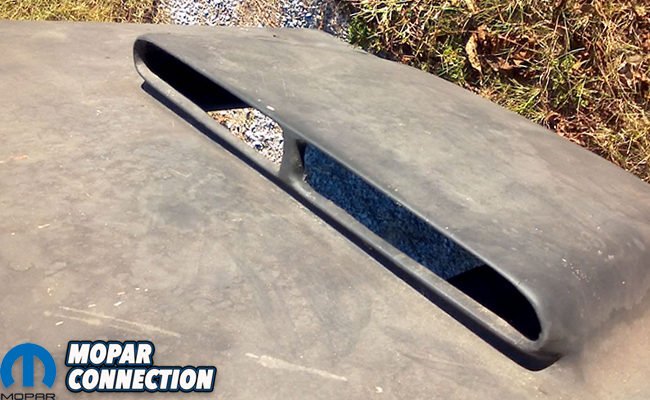

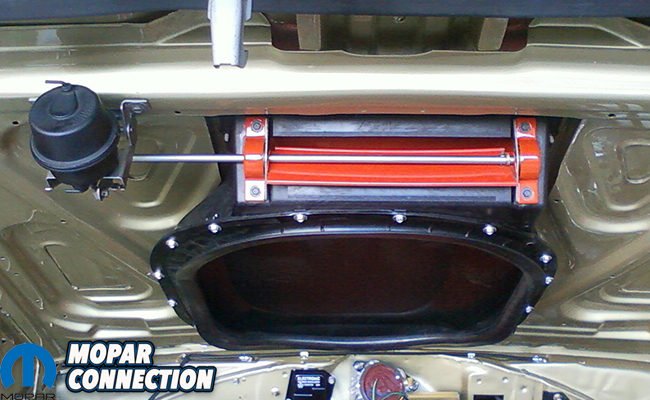
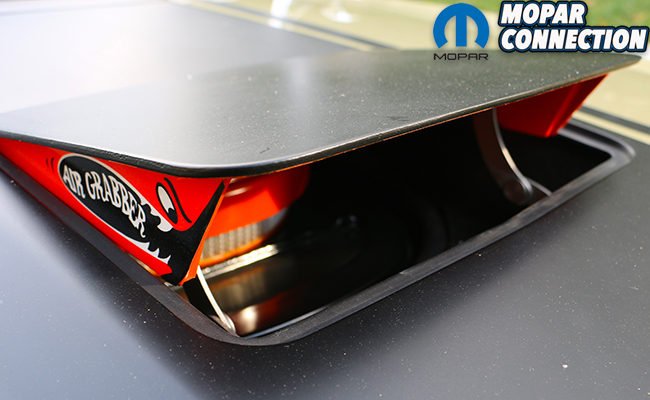
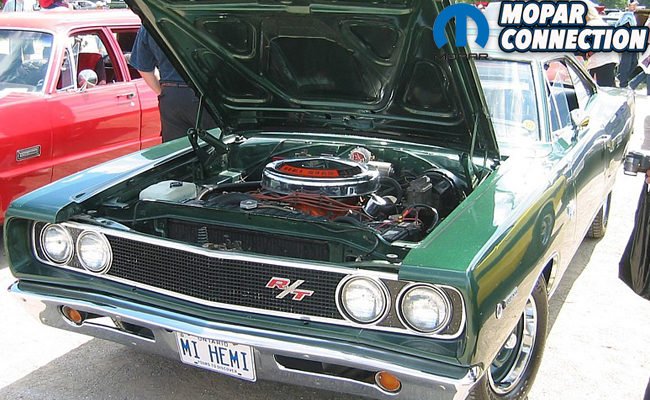

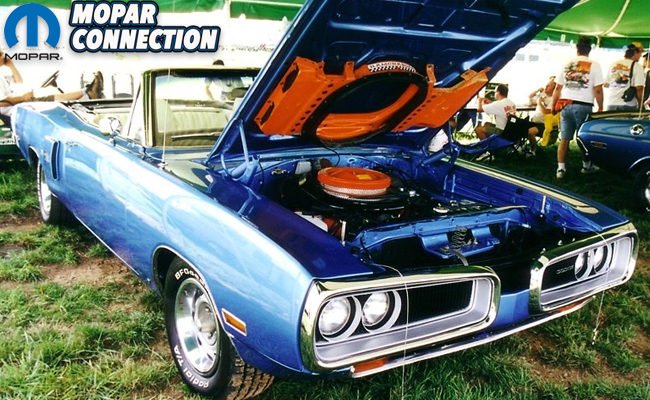

























Hi Mike, I am wondering if you might be able to help me out here. I am a retired show quality body and paint man, who has won many of the major car shows in America. I have been looking for all the OEM muscle car hoods of the 1960’s- and early 1970’s for the last 16 years. OEM only. I am restoring them all for an art installation where they will all be showcased. I want all the muscle cars to be represented in one viewing. These hoods are what inspired me to be a painter so long ago growing up with these beautiful cars. This is my contribution at the end of my career. I feel like it will be the ultimate tribute to American Muscle. I need your help finding these hoods, I have only these hoods to go, (so far I have 42) This show is my way of making sure that the beauty of that era will be saved forever, (as long as it can physically last, after a proper restoration). You would be contributing to this endeavor. This is my Opus. 🙂 Thanks for your help!
Here is my list of wants:
67 Belvedere (Large scoop)
67 Coronet R/T 440
67 Chevelle SS
68 Super Bee/Coronet
68 Shelby KR500
68 Impala SS
68 Yenko Camaro
68 Nova Stinger
69 Coronet R/T Dual scoop
69 Coronet Six Pack
69 Plymouth GTX
69 Charger
69 Barracuda w/scoops
69 Rambler
70 GTX
70 Coronet
70 Cuda
71 GTX
71 GTO ram air
71-74 Dart w/scoop(s)
Try Stephen’s Performance in Alabama.
They probably have all the Mopar hoods you are looking for.